
corky carroll : the curl line, 1967
| home | catalogue | history | references | appendix |
 |
surfresearch.com.au
corky carroll : the curl line, 1967 |
Importantly Carroll does emphasise the blending of a series of manoeuvres in to a "continuous flow," and as such the article could be viewed as a a mid-point between Bob McTavish's ground breaking articles of January 1967 and 1968.
At the beginning of 1967, McTavish presented a detailed catalogue of manoeuvres "to get involved... in a hairy position, under, in over, around the curl, quite often in contact with it;" hence, later often referred to as the Involvement School.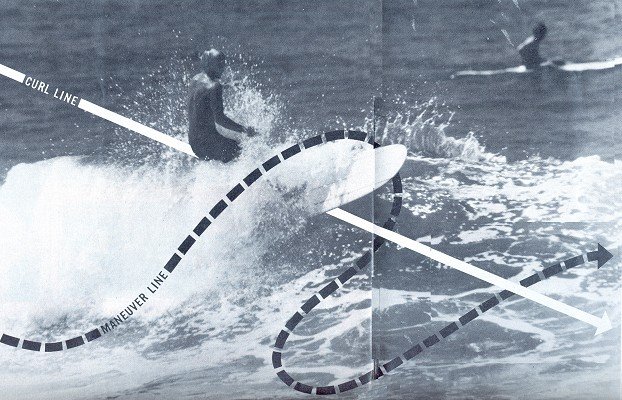
Page 57
Corky
Carroll, 1966 USSA and U.S. National Champion, analyzes a
new trend in surfing and compares it with the old style.
He talks
about a line of riding reference and how it relates to
progressive styles.
"the curl line"
by Corky Carroll
photos/Ron Stoner
The top
performers of surfing these days are developing a stylish
technique that uses the curl every second they are with the
wave.
I call this
technique "riding the curl line" because the surfer bases
every move on the speed and direction of the curl as it
moves toward the beach.
Of course,
surfers always have used the breaking portion of the wave as
a reference point for maneuvers.
However, in
the traditional style of yesterday, the surfer criss-crossed
back and forth across the wave's face moving away from the
curl and occasionally cutting back toward it.
Usually, the
surfer's direction was parallel to the beach while the wave
was breaking at a diagonal angle toward the shore.
Today's
surfer has evolved a technique so he moves in the direction
of the curl- on both sides of it- and becomes part of the
wave itself.
This
technique has a great deal in common with skiing.
The "fall
line" is a skiing term meaning the steepest, most direct
route down the mountain.
A skier
bases his moves around the fall line by maneuvering around
it according to the speed at which he wishes to travel.
Surfing has
a fall line, too- straight down the
Page 58
wave.
But because
in surfing the "mountain" is moving, surfing has a different
line of riding reference- the curl line.
Surfers have
adapted a technique of surfing around the curl line in order
to control the tempo of their riding.
Much as a
skier uses a series of short turns to slow himself down, a
surfer adjusts and readjusts his trim so as to stay as close
to the curl as possible.
In surfing
the curl line is based on the speed of the breaking curl and
the direction which the wave is moving toward the beach.
By
determining the point at which the curl will last break on
the beach and the best possible take-off spot (where the
curl will first break), a surfer can determine direction of
the curl and its speed.
Using this
as a guideline, he is able to base his maneuvers on this
direction, work-
Page 59
ing on both
sides of the curl line and getting much more out of the
wave.
This differs
from the "old" style of riding where the surfer constantly
tried to position himself on the curl line and ride away
from it. This technique allows a surfer to use all of the
power the wave has to offer.
There is
much more to it than just getting on a slight angle and
turning back and forth around the curl.
First of
all, there is the wave constantly moving and changing,
speeding up its curl or slowing it down, getting steeper or
flatter. This is where continuous flow becomes a necessity,
and only through being able to react to the wave, with the
wave, can a surfer really use this technique fully.
By putting
combinations of maneuvers together with the movement of the
wave, the surfer, his board
Page 60
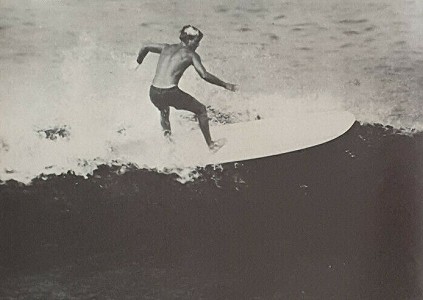
and the
wave become one motion.
It is
stylish and beautiful, and the rider never insults the wave;
he brings out the symmetric beauty of it and makes himself
part of it.
Once a rider adjusts his riding to the wave, he becomes rhythmical and combines his moves instead of making them separately. By using the curl line, he can maneuver into it and then follow through, setting himself right into the motion of flowing back into it.
There are
many different maneuvers and combinations.
The turn,
the side-slip, the nose ride, the stall, the climb, the
drop, the ins, the outs, the ups, the downs are all
maneuvers to control tempo.
But the one most important factor is trim, setting trim, breaking trim, adjusting, read-
Page 61
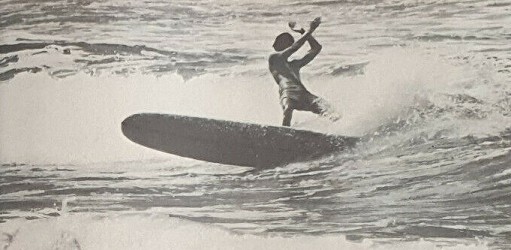 |
 |
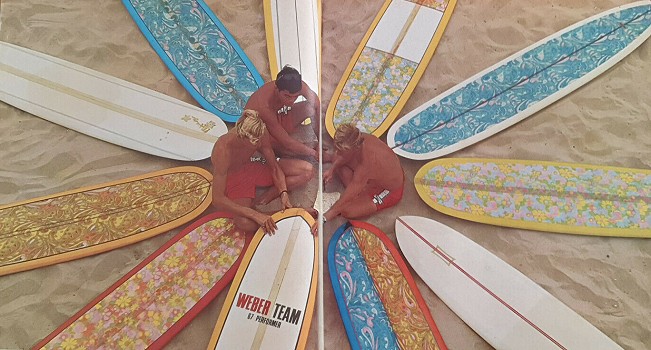

This
tested and proven bumper eliminates nose damage and costly
repairs.
Colors:
Red, blue, white, black, yellow, etc.
Only $3.95
(add 25c for mail order to handle packaging and shipping)
Dealer inquiries invited.
JOYCE RESEARCH INC./ 1402-08 Olympic Blvd., Santa Monica, Calif/EX 5-7771

STANDARD
CONFIGURATION Length 10' 5" Weight 39 1/2 Ibs. Thickness 3
15/16'' Width 22''
| As it moves back, wings open on both
sides of the "Power Skeg"C causing the board to
be pushed smoothly and rapidly forward.
As the skeg moves forward for the next stroke, the wings fold in and cause no drag. When you stand up to surf, the motor turns off, the skeg returns and locks into a normal surfing position. The specially designed, quiet running, dependable electric motor is powered by lightweight batteries. You can surf all day. At night, just "plug in your board" and the batteries art recharged for the next day's surfing. Rentals-Rental revenues are excellent. At $5 per hour rental fee, the board will pay for itself in a very short time. The powered board is the first out and the last in. Clubs -One or more boards per club will supply funds for your treasury. Aqua Jet is sold only through surf shops - see your local surlboard dealer. price--$500 F.O.B. San Francisco |
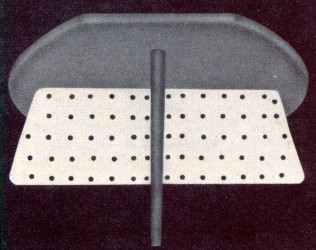 |
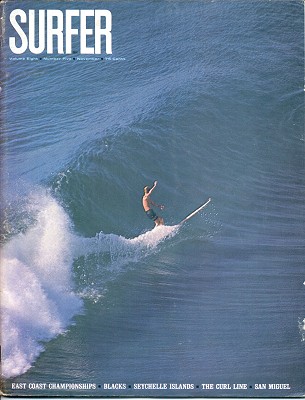 |
Volume 8 Number 5 November 1967. Cover: Copy courtesy of Graham Sorensen Collection. |

| home | catalogue | history | references | appendix |